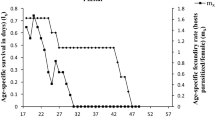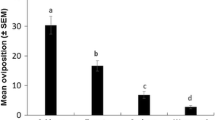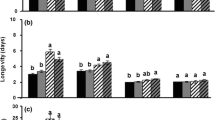Abstract
The effects of glandular trichome/methyl ketone (2-tridecanone and 2-undecanone) -based insect resistance in the wild tomato,Lycopersicon hirsutum f.glabratum C.H. Mull, accession PI 134417, onArchytas marmoratus (Townsend) andEucelatoria bryani (Sabrosky) (Diptera: Tachinidae), both parasitoids ofHelicoverpa (=Heliothis)zea (Boddie) (Lepidoptera: Noctuidae), were investigated in the laboratory.A. marmoratus deposits larvae (planidia) on the foliage of its host's food plant; planidia attach to passing hosts, penetrate the cuticle, and develop in the host pupae.E. bryani larviposits directly into its host; its larvae develop in the host larva.A. marmoratus planidia are killed by glandular trichomes of PI 134417 and also by trichomes of hybrid lines with no methyl ketones. The methyl ketones are toxic to planidia, but at least part of the effect is due to other factors, possibly physical entanglement. Both species can be affected indirectly by methyl ketones in the diet of the host. 2-Undecanone reduces the percentage ofA. marmoratus larvae that reach pupation. This effect is evidently due to premature death and desiccation of the host pupa caused by 2-undecanone. 2-Tridecanone in host diets had no effect onA. marmoratus. InE. bryani, 2-tridecanone in the diet of the host reduced the number of parasitoids yielded by each parasitized host, although not the overall percentage of hosts parasitized. 2-Undecanone in the diet of the host had no effect onE. bryani.
Similar content being viewed by others
References
Abbott, W.S. 1925. A method of computing the effectiveness of an insecticide.J. Econ. Entomol. 18:265–267.
Bergman, J.M., andTingey, W.M. 1979. Aspects of interaction between plant genotypes and biological control.Bull. Entomol. Soc. Am. 25:275–279.
Bryan, D.E.,Jackson, C.G., andStoner, A.1969. Rearing cotton insect parasites in the laboratory. U.S. Dept. Agric. Prod. Res. Rep. 109. 13 pp.
Bryan, D.E., Jackson, C.G., Neemann, E.G., andPatana, R. 1972. Production of progeny and longevity ofEucelatoria sp. parasitic in Heliothis species.Environ. Entomol. 1:23–26.
Burton, R.L. 1970. A low-cost artificial diet for the corn earworm.J. Econ. Entomol. 63:1969–1970.
Dimock, M.B., Kennedy, G.G., andWilliams, W.G. 1982. Toxicity studies of analogs of 2-tridecanone, a naturally occurring toxicant from a wild tomato.J. Chem. Ecol. 8:837–842.
Duffey, S.S., andBloem, K.A. 1986. Plant defense-herbivore-parasite interactions and biological control, pp. 135–183,in M. Kogan (ed.). Ecological Theory and Integrated Pest Management Practice. Wiley, New York.
Duffey, S.S., Bloem, K.A., andCampbell, B.C. 1986. Consequences of sequestration of plant natural products in plant-insect-parasitoid interactions, pp. 30–60,in D.J. Boethel and R.D. Eikenbury (eds.. Interactions of Plant Resistance and Predators and Parasitoids of Insects. Ellis Horwood, Chichester, U.K. 224 pp.
Farrar, R.R., Jr., andKennedy, G.G. 1987a. Growth, food consumption and mortality ofHeliothis zea larvae on foliage of the wild tomatoLycopersicon hirsutum f.glabratum and the cultivated tomato,L. esculentum.Entomol. Exp. Appl. 44:213–219.
Farrar, R.R., Jr., andKennedy, G.G. 1987b. 2-Undecanone, a constituent of the glandular trichomes ofLycopersicon hirsutum f.glabratum: Effects onHeliothis zea andManduca sexta growth and survival.Entomol. Exp. Appl. 43:17–23.
Farrar, R.R., Jr., andKennedy, G.G. 1988. 2-Undecanone, a pupal mortality factor inHeliothis zea: Sensitive larval stage and in planta activity inLycopersicon hirsutum f.glabratum. Entomol. Exp. Appl. 47:205–210.
Farrar, R.R., Jr., andKennedy, G.G. 1991. Inhibition ofTelenomus sphingis an egg parasitoid ofManduca spp. by trichome/2-tridecanone-based host plant resistance in tomato.Entomol. Exp. Appl. 60:157–166.
Gross, H.R., Jr., andJohnson, R. 1985.Archytas marmoratus (Diptera: Tachinidae): Advances in large-scale rearing and associated biological studies.J. Econ. Entomol. 78:1350–1353.
Hughes, P.S. 1975. The biology ofArchytas marmoratus (Townsend).Ann. Entomol. Soc. Am. 68:757–767.
Hughes, P.S., andRabb, R.L. 1976. A survey of tachinid parasites ofHeliothis zea andH. virescens in North Carolina.J. Ga. Entomol. Soc. 11:259–265.
Jackson, C.G., Bryan, D.E., andPatana, R. 1969. Laboratory studies ofEucelatoria armigera (Coquillett), a tachinid parasite ofHeliothis spp.J. Econ. Entomol. 62:907–910.
Kashyap, R.K., Kennedy, G.G., andFarrar, R.R., Jr. 1991. Behavioral response ofTrichogramma pretiosum Riley andTelenomus sphingis (Ashmead) to trichome/methyl ketonemediated resistance in tomato.J. Chem. Ecol. 17:543–556.
Kauffman, W.C., andKennedy, G.G. 1989a. Inhibition ofCampoletis sonorensis parasitism ofHeliothis zea and of parasitoid development by 2-tridecanone-mediated insect resistance of wild tomato.J. Chem. Ecol. 15:1919–1930.
Kauffman, W.C., andKennedy, G.G. 1989b. Relationship between trichome density in tomato and parasitism ofHeliothis spp. (Lepidoptera: Noctuidae) eggs byTrichogramma spp. (Hymenoptera: Trichogrammatidae).Environ. Entomol. 18:698–704.
Kauffman, W.C., andKennedy, G.G. 1989c. Toxicity of allelochemicals from wild insect resistant tomatoLycopersicon esculentum toCampoletis sonorensis, a parasitoid ofHeliothis zea.J. Chem. Ecol. 15:2051–2060.
Kennedy, G.G. 1986. Consequences of modifying biochemically mediated insect resistance inLycopersicon species, pp. 130–141,in M.B. Green and P.A. Hedin (eds.. Natural Resistance of Plants to Pests: Roles of Allelochemicals. ACS Symposium Series 296. American Chemical Society, Washington, D.C.
Kennedy, G.G., andFarrar, R.R., Jr. 1987. Response of insecticide-resistant and susceptible Colorado potato beetles,Leptinotarsa decemlineata to 2-tridecanone and resistant tomato foliage: The absence of cross resistance.Entomol. Exp. Appl. 45:187–192.
Kennedy, G.G., andHenderson, W.R. 1978. A laboratory assay for resistance to the tobacco hornworm inLycopersicon andSolanum spp.J. Am. Soc. Hortic. Sci. 103:334–336.
Kennedy, G.G., andSorenson, C.E. 1985. Role of glandular trichomes in the resistance ofLycopersicon hirsutum f.glabratum to Colorado potato beetle (Coleoptera: Chrysomelidae).J. Econ. Entomol. 78:547–551.
Kennedy, G.G., andYamamoto, R.T. 1979. Resistance in a wild tomato to the tobacco hornworm: The presence of a toxic factor.Entomol. Exp. Appl. 26:121–126.
Kennedy, G.G.,Sorenson, C.E., andFery, R.L. 1985. Mechanisms of resistance to Colorado potato beetle in tomato, pp. 107–116,in D.N. Ferro and R.H. Voss (eds.). Proceedings of the Symposium on the Colorado Potato Beetle, XVIIth International Congress of Entomology. Mass. Agric. Exp. Sta. Res. Bull. 704. 144 pp.
Lin, S.Y.H., Trumble, J.T., andKumamoto, J. 1987. Activity of volatile compounds in glandular trichomes ofLycopersicon species against two insect herbivores.J. Chem. Ecol. 13:837–850.
Luckwill, L.C. 1943. The genusLycopersicon; an historical, biological, and taxonomic survey of the wild and cultivated tomatoes. Aberdeen University Studies No. 120.
Obrycki, J.J. 1986. The influence of foliar pubescence on entomophagous species, pp. 61–83,in D.J. Boethel and R.D. Eikenbury (eds.. Interactions of Plant Resistance and Parasitoids and Predators of Insects. Ellis Horwood, Chichester, U.K. 224 pp.
Price, P.W. 1986. Ecological aspects of host plant resistance and biological control: Interactions among three trophic levels, pp. 11–30,in D.J. Boethel and R.D. Eikenbury (eds.. Interactions of Plant Resistance and Parasitoids and Predators of Insects. Ellis Horwood, Chichester, U.K. 224 pp.
van Emden, H.F. 1986. The interaction of plant resistance and natural enemies: Effects on populations of sucking insects, pp. 138–150,in D.J. Boethel and R.D. Eikenbury (eds.. Interactions of Plant Resistance and Parasitoids and Predators of Insects. Ellis Horwood, Chichester, U.K. 224 pp.
Williams, W.G., Kennedy, G.G., Yamamoto, R.T., Thacker, J.D., andBordner, J. 1980. Two-tridecanone: A naturally-occurring insecticide from the wild tomatoLycopersicon hirsutum f.glabratum.Science 207:888–889.
Author information
Authors and Affiliations
Additional information
We thank M. Woodall for typing; V.B. Covington, D. Bumgarner, and B. O'Brien for technical assistance; L.A. Jones for assistance with gas chromatography; P.H. Adler for supplyingE. bryani puparia to initiate colony; and Drs. F. Gould, G.C. Rock, and M. Barbercheck for comments.
Rights and permissions
About this article
Cite this article
Farrar, R.R., Kennedy, G.G. & Kashyap, R.K. Influence of life history differences of two tachinid parasitoids ofHelicoverpa zea (Boddie) (Lepidoptera: Noctuidae) on their interactions with glandular trichome/methyl ketone-based insect resistance in tomato. J Chem Ecol 18, 499–515 (1992). https://doi.org/10.1007/BF00994248
Received:
Accepted:
Issue Date:
DOI: https://doi.org/10.1007/BF00994248




